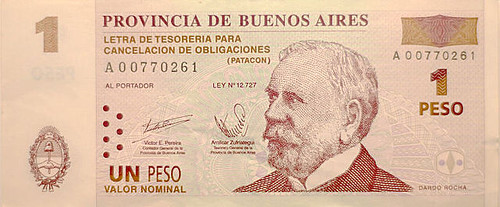
PREV ARTICLE
NEXT ARTICLE
FULL ISSUE
PREV FULL ISSUE
THE BIRTH OF A (PSEUDO) CURRENCYThis article, found via News & Notes from the society of Paper Money Collectors (Volume IX, Number 36, February 20, 2024), provides a great discussion on the market dynamics and lifecycle of substitute currencies. -Editor A dozen pseudo-currencies were issued in Argentina in 2002. How did that work? And why are they coming back in 2024? What is a pseudo-currency? How do they start? Why do they have value? Here is a Bono Patacon, emitted by the province of Buenos Aires: And here are some other designs from Buenos Aires and other provinces As a province you don't have the legal authority to issue "real" pesos. So, this is technically a bond but you hope people will accept it as pesos, because that is what people want. The utilities are accepting the bonds because you forced them to. The workers have no choice so they take what you give them, hoping they'll be able to spend these bonds somehow. Months go by and there are a lot of bonds circulating. Workers always try to pay first with the bonds, and only later with the relatively scarcer pesos. This is called Gresham's law: bad money drives out good money. This results in the baker receiving more bonds than it needs to pay for taxes and utilities. When he tries to pay for flour with them, the supplier rejects it because he too has too many bonds. They negotiate and the supplier is willing to accept bonds at a 5% discount to pesos. So, if flour was ARS 100 per kilogram, the baker has to pay 105 bonds for it. To reflect this, the baker sets a sign in their store "Bonds accepted at 0.95". The other bakers all have the same problem, so they do the same. Your pseudo-currency now has an exchange rate, given by the "market". This is a very decentralized market with no clearing house. Instead, each gas station, grocery store, hair salon, etc decides how many bonds to accept and at what rate. But if anybody of them undervalues the bonds with respect to the market, their customers go to the competition. This goes on until your provincial government or the federal government has enough pesos to exchange for the bonds. One way this can happen is when the federal government agrees to start printing pesos again. When you own the printer, everything is possible. Then, when the government starts trading pesos for bonds, everybody rushes to convert them, and they quickly disappear. Your pseudo-currency doesn't exist anymore.
To read the complete article, see:
Wayne Homren, Editor The Numismatic Bibliomania Society is a non-profit organization promoting numismatic literature. See our web site at coinbooks.org. To submit items for publication in The E-Sylum, write to the Editor at this address: whomren@gmail.com To subscribe go to: https://my.binhost.com/lists/listinfo/esylum All Rights Reserved. NBS Home Page Contact the NBS webmaster 
|

